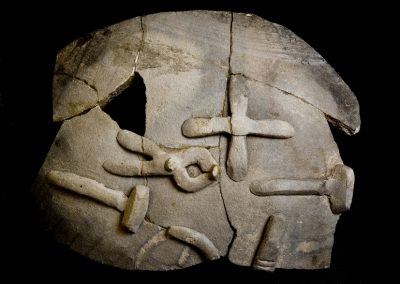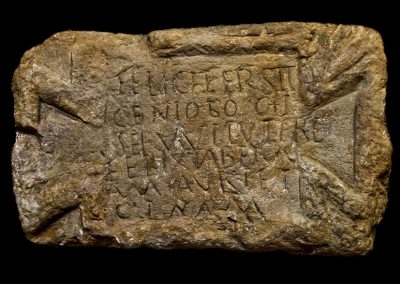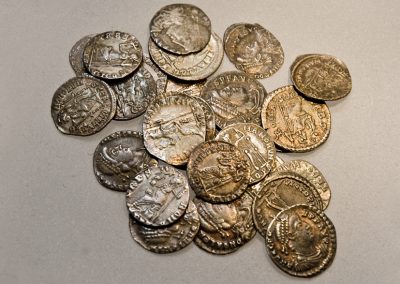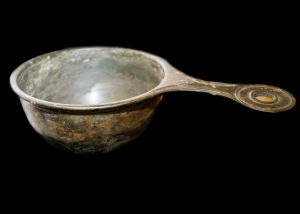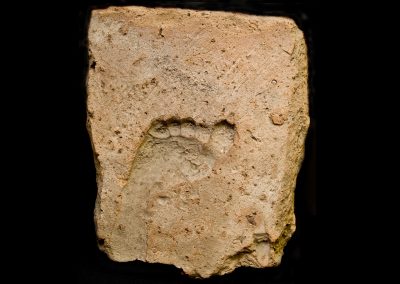What can we discover from exploring Roman Milestones?
There are over 100 inscribed Roman milestones known about in Britain. Together, they give us a huge amount of information about the Romans – their roads, networks and population centres, as well as details of emperors.
You can recognise these stone pillar from their Latin inscriptions which usually give the distance to the next town. Other information usually includes the name of the reigning emperor at the time the stone was placed, as well as the year of his reign at that time.
The stones were positioned when a road was first constructed or later mended, so this information can help historians to determine Roman activities in an area. Having a dated object from the past is also particularly helpful.
Roman Milestone
Aldborough Roman Site, North Yorkshire, English Heritage
This Roman milestone can be seen at Aldborough Roman Site (English Heritage) in North Yorkshire.
It contains two different inscriptions, the first for Augustus, and the second for the Emperor Caesar Gaius Messius Quintus Trajanus Pius Felix Augustus, the good, happy and great.
Decius was Emperor from 249 to 251 CE. It’s not known why this stone was re-used and it may be that the later inscription and use date from a period when the stone could have switched use from a milestone to a dedication stone. Dedication stones were often placed in prominent positions, such as the entrance of a building or near the structure being dedicated.
This stone was found in 1776 about two miles from Aldborough, at Duel Cross, three miles north of the Roman road to Catterick.
Roman Milestone
Dales Countryside Museum, Hawes
This milestone can be found at the Dales Countryside Museum in North Yorkshire. it was found in 1924 at the side of the road at Stainmore.
The road through Stainmore Gap, which crosses the Pennines above Swaledale was an important part of the road network by which the Romans controlled the Dales.
The Latin inscription has been inscribed over again at a later date. The initial text reads, providing us with two distinct stories. The original inscription reads:
Imp(eratori) C(aesari) M(arco)
Annio
Flor[i]ano
P(io) F(elici) Aug(usto)
‘For the Emperor Caesar Marcus Annius Florianus Pius Felix Augustus’.
The secondary/top level text reads:
Imp(eratori) C(aesari) M(arco)
Aurelio
Probo
P(io) F(elici) Aug(usto)
‘For the Emperor Caesar Marcus Aurelius Probus Pius Felix Augustus’.
This is helpful for dating the stone. Florian was the Emperor in 276 CE, followed by Probus from 276 – 82 CE. Perhaps the stone had just been carved as word reached the Romans in Britain of the death of Florian.
After the Romans
Milestones continued to be used long after the Roman period. In 1555 an Act of Parliament made local parishes responsible for maintaining roads, and guideposts were commonplace.
The difficult terrain on some roads, such as those across moorland, made travel slow and difficult. To deal with this problem so-called ‘Turnpike Trusts’ were set up by Acts of Parliament from 1706 to the 1840s. These Trusts usually comprised of groups of local business people and landowners who improved or built stretches of road and paid for these improvement by charging users a toll. By the 1840’s rail travel had taken over road use for longer journeys and many Turnpike Trusts ceased to exist.
Watch the Video – to find out what we can learn from a milestone
Watch The Video With Subtitles
Talking Points
Roman milestones were usually made of stone. Why do think this material was used?
Why do think Roman milestones often had the name of the Emperor carved on them as well as distance to the next town?
Why do you think milestones fell out of use?
As well as distance, can you think of other things it may be useful to know if you were travelling?
Milestones continued to be made and used for centuries on roads and byways in Britain. Have you ever seen one or something similar?

Hands on History
The Dales Countryside Museum has a popular programme of workshops for schools, including a Roman Loan Box, you can find more information here.
Schools can also book a free self-led visit to Aldborough Roman Site (English Heritage). Groups can explore the museum and discover the amazing array of Roman objects reflecting everyday life.
Find out more about the incredible range of Roman inscriptions to be found across the UK.
Explore more Roman objects




